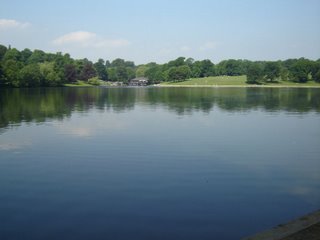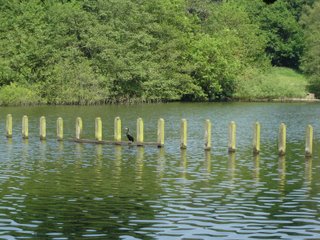Escaped from Flannan Isle
Mostly, of course, we get the same kinds - sparrows, blackbirds, bluetits, great tits, thrushes, magpies, collared doves, woodpigeons - - and the occasional rarer ones like yesterday's goldfinch.
And a mile or so away in Roundhay Park there are plenty of ducks and crows and geese and I usually feed them, too, as I walk round Waterloo Lake, which was looking particularly good this morning.

At the far end of the lake there are some fence posts sticking up, and often there is a line of gulls sitting on them, though there wasn't today:

What's that in the middle of the picture? Zooming in, I found this:

So what on earth is it? Huge great bird, about the size of a heron - in fact I thought it was some kind of black heron at first, but I don't think so, I think it has webbed feet for a start, and a heron doesn't.
Nobody else seemed much bothered by it - and there were lots of people in the park - so perhaps I'm the last person in Leeds to find out about the Big Black Bird of Roundhay Park. It looked like one of the three black birds in Wilfred Wilson Gibson's poem about the 1900 mystery of Flannan Isle, where the three lighthouse-keepers disappeared:
And as into the tiny creek/We stole beneath the hanging crag/We saw three queer, black, ugly birds/Too big by far, in my belief/For guillemot or shag/Like seamen sitting bolt upright/Upon a half-tide reef/But, as we neared they plunged from sight/Without a sound or spurt of white.
Well, Wilfred, I think what your narrator saw were cormorants. And, if we weren't sixty miles inland, I'd say this was a cormorant too. You know, big black things, perched on a rock out at sea, often seen with their wings spread out drying in the sun. Not usually found on a lake in Leeds with a lot of ducks and coots and the occasional heron.
Here's a link to a picture of a cormorant. If you can confirm or deny, or come up with any other theories, please let me know, because I'm a bit out of my depth with this one.
I'm going back to feeding the birds in my garden now. Tomorrow perhaps I'll find a golden eagle on the bird table.

3 Comments:
Perhaps it is feasting on all the corpses in Waterloo Lake (someone intent upon wooing me once explained that it's an important dumping ground for anyone surplus to the requirements of Leeds' criminal gangs...?). If something eats fish, it could adapt and eat corpses, surely?
(I didn't go out with the guy).
I've seen quite a few cormorants in my time, and it definitely looks like one! I've never seen one that close, as they're usually perched on a rock out in a roaring sea rather than taking the air in a park, but why shouldn't a cormorant have an easy life?
it's a duck disguised as a cormorant waiting for a shag
Post a Comment
<< Home